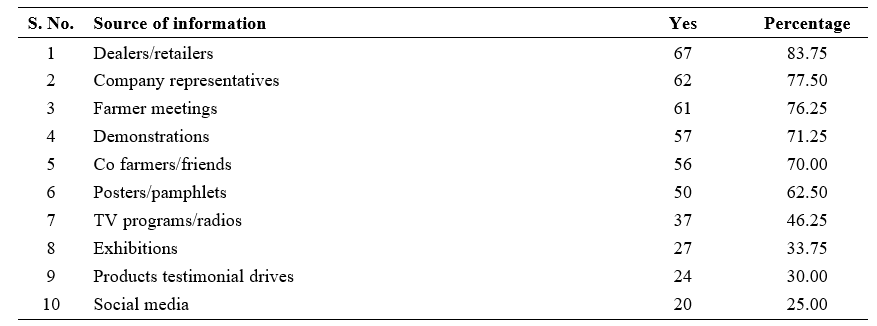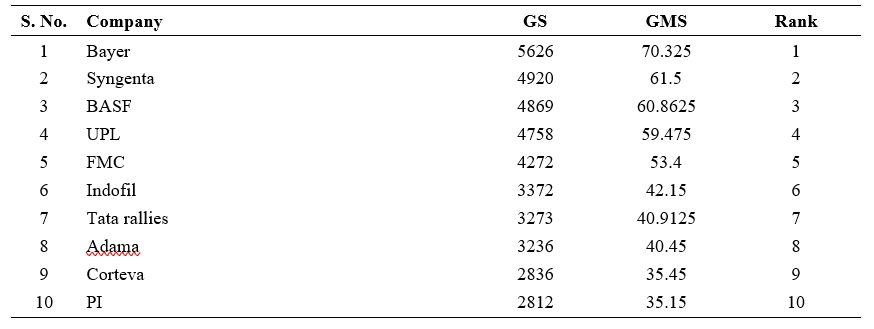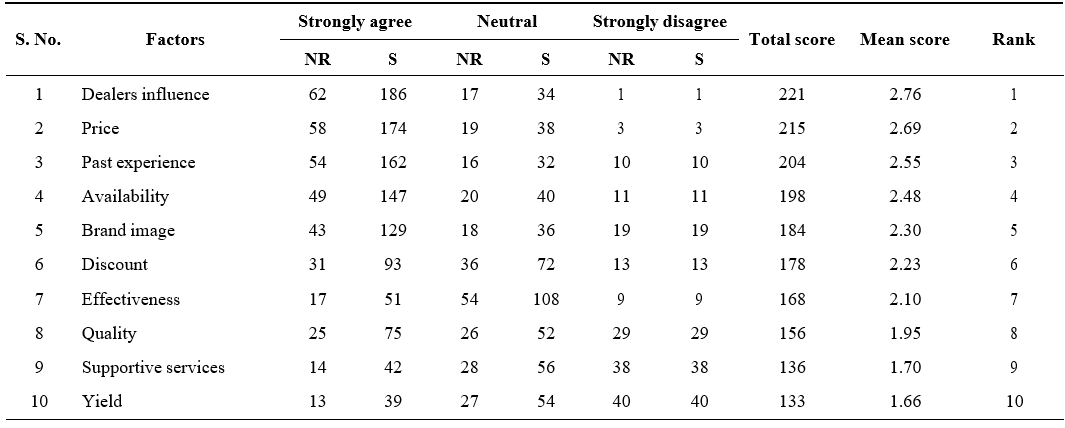Identifying the Factors Influencing Brand Preference for Pesticides in Guntur District
0 Views
MANDA HARISH*, CH. SRILATHA VANI, OBULA REDDY SARADA AND P. LAVANYA KUMARI
Institute of Agribusiness Management, S.V. Agricultural College, ANGRAU, Tirupati – 517 502.
ABSTRACT
Agriculture plays a crucial role in India’s economy, providing sustainability for over 54.6% of rural households and contributing 18.3% to the GDP during the year 2022-23. In the pursuit of ensuring food security and maximizing agricultural productivity, the use of pesticides has emerged as a critical aspect of modern farming practices. The aim of the current study, “Identifying the factors influencing brand preference for pesticides in Guntur district of Andhra Pradesh” embraces sources that influence brand preference and various factors that influence the brand preference. This study was conducted in the Guntur district of Andhra Pradesh and for the study ex-post facto research design was followed. It explored sources of information on pesticide brands such as price, availability, dealers influence, peer recommendations, brand image, and past experiences were examined to understand the driving forces behind the brand selection. The farmers preference for pesticides is influenced by mostly dealers influence (mean score of 2.76), price (mean score of 2.69), past experience (mean score of 2.55), availability (mean score of 2.48) and brand image (mean score of 2.30). The results reveal that major problems encountered by the farmers during the purchase of pesticides were price, lack of credit facility, non availability of preferred pesticides at their need and lack of technical knowledge of what to buy and how much to use. the frequency and reach of these information sources, as they play a crucial role in influencing farmers decision-making processes.
KEYWORDS: Brand preference, Pesticides, Ex-post facto research design, Farmers.
INTRODUCTION
Agriculture is responsible for providing sustenance to up to 58 per cent of India’s population. Furthermore, the agricultural sector and its allied industries contribute substantially to the nation’s Gross Domestic Product (GDP), accounting for 18.30 percent during the year 2022-2023. Insecticides, herbicides, rodenticides, nematicides, and fungicides are a diverse range of pesticides utilized in agronomic practices to manage pests, weeds, and plant diseases effectively. This research aims to analyze farmers pesticide brand preferences in the agricultural sector, with a particular focus on the district of Guntur. Based on various sources of pesticide brand information and factors that influence farmers decisions while choosing specific pesticide brands. Factors such as price, availability, dealer influence, peer recommendations, brand image, and past experiences were examined to understand the driving forces behind brand selection. Additionally, the research will investigate the frequency and reach of these information sources, as they play a crucial role in influencing farmers decision- making processes. Promotional strategies to encourage pesticide brand purchases encompass demonstrations, mega farmers programs, and farmer meetings for direct engagement. TV/radio, pamphlets/posters, and vehicle campaigns use visual and auditory means for wider recruiting purposes. Exhibitions and product endorsement campaigns highlight the advantages of a brand. Social media is becoming more important, and FTPs educate farmers about the application of pesticides.
MATERIAL AND METHODS
The study was conducted in Guntur district of Andhra Pradesh during the year 2023 and ex-post facto research design was followed for the study. Guntur district of Andhra Pradesh was purposively selected for the study as the district occupies first place in the consumption of pesticides in Andhra Pradesh. Among the 56 mandals, four mandals were selected purposively based on the highest consumption of pesticides i.e., Thadikonda, Prathipadu, Medikondur and Phirangipuram. From these selected mandals, a total of eight villages were selected randomly viz., Thadikonda, Ravela, Mandapadu, Siripuram, Takkelapadu, Thalluru, Gottipadu and Mallayapalem. After the selected villages were listed ten farmers from each village were randomly selected for the survey thus making the total sample size of 80. The primary data regarding the socio-economic
Table 1. Classification of Source of brand information reach to respondents

profile of sample farmers, farmers pesticide buying behaviour, factors influencing brand preference of pesticides, research of various promotional strategies used by different companies and constraints faced by them in purchasing process of pesticides were collected using an interview schedule. The data collected were subjected to the appropriate set of statistical tools to arrive at valid conclusions. Collected data was statistically analyzed using SPSS program, frequencies percentages, mean, standard deviation, percentages, Garret’s ranking technique and Likert scale. This approach provided a detailed and nuanced understanding of the dataset.
RESULTS AND DISCUSSIONS
I. Classification of Sources of brand information reach respondents
There are different sources that provide information on pesticide brands to farmers including demonstrations, exhibitions, pamphlets/posters, dealers/retailers, co- farmers/friends, TV programs / radios, company representatives, product testimonial drives, social media and farmer meetings. Table 1 shows that the top five sources of brand information were dealers/retailers at 83.75 per cent followed by company representatives at 77.50 per cent, farmer meetings at 76.25 per cent demonstrations at 71.25 per cent and co-farmers / friends at 70.00 per cent.
II. Ranking for top brands of pesticides in Guntur district
The ranking is given based on purchase behavior and farmers preference for the purchase and consumption.
Table 2. Ranking for top brands of pesticides in Guntur district

Table 3. Factors affecting the farmers preference towards specific pesticides brands

Table 2 indicates that the top 5 pesticide companies preferred by farmers in the Guntur district were Bayer at 1st rank, Syngenta at 2nd rank, BASF at 3rd rank, UPL at 4th rank and FMC at 5th rank. The data highlights the competitive landscape of the pesticide industry, where companies like Bayer, Syngenta, BASF, and UPL hold prominent positions due to their market share. The ranking is given based on the purchase behaviour and farmers preference for the purchase and consumption. The major top 10 companies in the Guntur district as per consumption include Bayer, Syngenta, BASF, UPL, FMC, Indofil, Tata rallies, Adama, Corteva and PI. Top brands of pesticides were selected based on the garret ranking technique.
III. Factors affecting the farmers preference towards specific pesticide brands
The data presented in Table 4.3 highlights the key factors influencing farmers preferences toward specific pesticide brands. Dealers influence emerged as the most critical factor, with a high score of 221 and a mean of 2.76, indicating that farmers have trust in dealers recommendations when making their choices. Price was the second most influential factor, score of 215 with a mean of 2.69, suggesting that cost plays a significant role in farmers decision-making. Past experience ranked third, with a score of 204 and a mean of 2.55, signifying that farmers previous encounters with certain brands heavily influence their current preferences. Understanding these factors is essential for pesticide companies to tailor their marketing strategies and offerings to meet farmers preferences and needs effectively.
In conclusion, the study revealed the behaviour of farmers regarding factors influencing farmers pesticide brand preferences, with dealers’ influence and pricing being the most significant. Companies like Bayer, Syngenta, BASF, and UPL hold prominent positions in the competitive pesticide market in Guntur district. Farmers preferences for pesticide brands were significantly influenced by dealers’ influence, price, and past use they placed a high value on price consideration along with dealers influence. Past interactions with particular brands also played a big role. Even though aspects like availability, brand image and discounts had considerable impact, their significance was somewhat limited. Therefore, pesticide businesses must tailor their marketing strategies and products depending on these factors to effectively cater to farmers preferences and needs.
LITERATURE CITED
Chaudhary, A.N.A.M., 2018. A study of market analysis of pesticides. International Journal of Agricultural Science and Research. 8(6): 7-14.
Mamta R., Choudary, R and Purohit, H. 2015. Promotional measures used by companies to attract consumers. Journal of Business and Management. 29(2): 20-27.
Senthilnathan, S., Kanchana, K., Vinothkumar, B and Saravanakumar, V. 2022. Branding influence on farmers decisions to purchase agrochemicals in Tamil Nadu. The Pharma Innovation Journal. 11(7): 3301-3303.
Sundersingh, G. 2012, A study on farmer’s preference for pesticide brand and promotional strategies of pesticide companies in Chikkballapura district. MBA (ABM) Thesis. University of Agricultural Sciences Bengaluru.
Yaswanth, C. 2020. Buying behaviour of farmers towards pesticides in Kurnool district of Andhra Pradesh. MBA (ABM) Thesis. Acharya N.G. Ranga Agricultural University Lam, Guntur, Andhra Pradesh.
- Bio-Formulations for Plant Growth-Promoting Streptomyces SP.
- Brand Preference of Farmers for Maize Seed
- Issues That Consumer Experience Towards Online Food Delivery (Ofd) Services in Tirupati City
- Influence of High Density Planting on Yield Parameters of Super Early and Mid Early Varieties of Redgram (Cajanus Cajan (L.) Millsp.)
- Influence of Iron, Zinc and Supplemental N P K on Yield and Yield Attributes of Dry Direct Sown Rice
- Effect of Soil and Foliar Application of Nutrients on the Performance of Bold Seeded Groundnut (Arachis Hypogaea L.)

